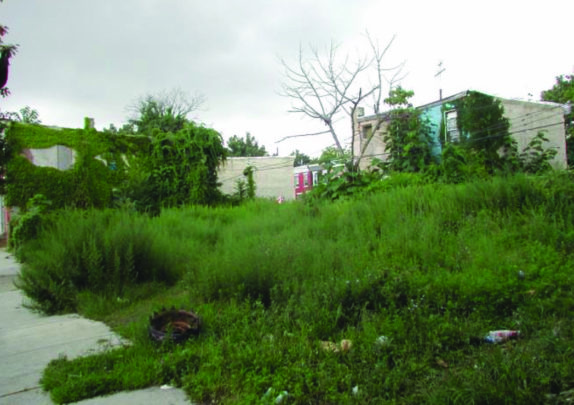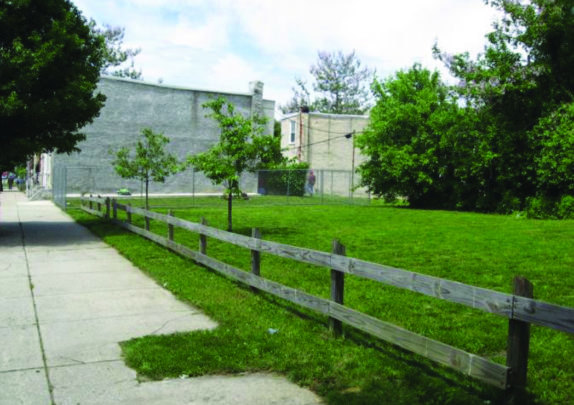Approach
One significant environmental factor that influences the prevalence of lethal violence in high-risk areas is a concentration of blighted properties.1Matthew Valasik, Elizabeth E. Brault, and Stephen M. Martinez, “Forecasting Homicide in the Red Stick: Risk Terrain Modeling and the Spatial Influence of Urban Blight on Lethal Violence in Baton Rouge, Louisiana,” Social Science Research 80 (May 2019): 186-201. Neighborhoods that are physically neglected can create a sense of disorder and an increase in the fear of crime. Crime Prevention Through Environmental Design (CPTED) programs aim to reduce crime and the fear of crime in specific areas via the design and management of the physical environment (e.g., buildings, landscaping, traffic ways, and architectural structures).2Dan Fleissner and Fred Heinzelmann, “Crime Prevention through Environmental Design and Community Policing,” US Department of Justice, National Institute of Justice, August 1996. CPTED is a multidisciplinary approach to changing the physical environment in ways that positively influence human behavior.3National Crime Prevention Council, “Crime Prevention Through Environmental Design Training Program,” accessed on May 22, 2019, https://www.ncpc.org/resources/home-neighborhood-safety/crime-prevention-through-environmental-design-training-program/
CPTED operates on four principles: access control, increased visibility, territoriality, and maintenance. Access control refers to entryways and gateways (e.g., streets, sidewalks, building entries, and fences) that clearly indicate transitions from public spaces to semi-private and private areas. Increased visibility is a design principle that maximizes visibility in a space and involves the strategic placement of windows, doors, paths, parking lots, etc. Territoriality refers to physical design that reinforces public versus private areas. This includes strategic landscaping and structures such as porches that demonstrate “ownership” of a space. Maintenance is the regular upkeep and management of a space to show that the area is cared for and watched.4National Crime Prevention Council. “Best Practices for Crime Prevention Through Environmental Design Using Weed and Seed Sites,” 2019, http://bit.ly/31zGr5D.
Impact
Research on crime prevention through environmental design generally suggests that environmental remediation strategies result in localized reductions in crime and gun violence.
Other benefits
Other quality of life improvements for community members include greater perceptions of safety and an increased likelihood of relaxing and socializing outdoors in their neighborhood.5Charles C. Branas et al., “Citywide Cluster Randomized Trial to Restore Blighted Vacant Land and Its Effects on Violence, Crime, and Fear,” Proceedings of the National Academy of Sciences 115, no. 12 (February 2018): 2946–2951.


Necessary Resources
Committed partnerships are essential to CPTED initiatives. Depending on the size and scope of the intended project, designated city personnel (e.g., city planning, mayor’s office, law enforcement) are necessary, and hiring considerations would be based on the needs of your program. Identify and utilize existing resources and funding first. Look for community and business partnerships that would enhance your efforts, as well as benefit those stakeholders. CPTED partners need to be willing to commit time, resources, staff, and possibly funding (where appropriate) to the program.
Strategy in Practice
Overview
The scope of a CPTED can vary greatly, and partners can utilize a wide variety of strategies and tools to accomplish their goals. Remedies can include tasks like picking up trash regularly in an area, updating a community playground, and improving street lighting. More complex strategies can include a complete redesign of a blighted space, implementing city ordinances for property owners, and incorporating social services and youth programs. See Newsroom/Resources section for specific examples of CPTED programs in action in cities across the country.
First, a specific area(s) must be identified and assessed for improvement. This step includes collecting crime data and quality of life input from several sources, including residents, law enforcement, community groups and businesses, property managers, city personnel, and other stakeholders. Create a working group or committee of diverse but invested partners to identify the problems, the goals (short- and long-term), and the potential challenges to reaching those goals. Identify the benefits of a successful program for each stakeholder. Second, use the principles of CPTED to problem-solve and develop an action plan for the designated space(s). The plans should include specific steps designating who is responsible for accomplishing them and how. Encourage creativity and collaboration between partners to solve problems. Establish regular meetings to provide updates regarding the action plan, discuss challenges, and determine any impacts of the program. Maintain accurate and timely data on the process and impact of all CPTED projects. Keep all stakeholders informed of program progress, and track successes as well as changes that need to be made.6Ibid.,7Julia Ryan, “What is CPTED and How Can It Help Your Community?” National Training and Technical Assistance Center, July 10, 2014, http://bit.ly/2P5CPFF.
Common Barriers
The scope of a city’s CPTED program may be limited by funding options. However, short- and long-term goals can be established and plans implemented along a flexible timeline as tasks are accomplished and additional funding is secured. Additionally, continuous buy-in and management of the improved space(s) is necessary and must be addressed long-term.
Agencies, Organizations, and Other Necessary Partners
Most CPTED programs and efforts are led by either local city planners and/or a community organization (e.g., neighborhood HOA, community service group, local nonprofit, place of worship). CPTED is a multidisciplinary approach that requires buy-in and commitment from several entities for success. A diverse working group is critical; however, one organization or partnership needs to be designated as the lead in order to efficiently manage the program. Supporting partners should include community businesses, neighborhood leaders and residents, and local law enforcement. Depending on the scope of the project, architects, interior designers, building contractors, professional landscapers, etc. may need to be included in the efforts. Local universities can also be included in order to have the program impact rigorously evaluated.
What else you need to know
Community/partner support and buy-in is critical for successful CPTED programs. Be conscientious of the community in and around the area that is designated for improvement. Look for ways to collect information from those who will be impacted by the changes, using community surveys, interviews, and meetings. For example, the National Crime Prevention Council provided technical assistance to several cities to develop and implement CPTED programs. The process began by collecting community input regarding safety, crime, and quality-of-life issues, as well as suggested solutions. This was accomplished through questionnaires, telephone interviews, and site visits.8National Crime Prevention Council, “Best Practices.”
Newsroom & Resources
-
National Institute of Justice “Research in Action”
This article summarizes how CPTED programs and community policing strategies can complement each other and work cohesively to address crime and quality-of-life issues in specific neighborhoods. This brief also provides specific examples of cities that utilized these strategies and steps that other localities can take to initiate their own plans.
-
The National Crime Prevention Council
The National Crime Prevention Council offers a variety of training courses on CPTED for members and also published a “Best Practices” document for using CPTED principles.
-
Everytown For Gun Safety: Examples of CPTED
Everytown For Gun Safety provides several examples of CPTED in cities across the country.
-
“Crime Prevention Through Environmental Design in Flint, MI”
“Crime Prevention Through Environmental Design in Flint, MI” is an interactive website describing CPTED interventions in 2012 in the University Avenue Corridor.
-
The Prince William County (VA) Police Department
The Prince William County (Virginia) Police Department offers a document that identifies CPTED strategies for a variety of areas, including private residences, multifamily complexes, parks, schools, shopping areas, parking garages, industrial areas, etc.
-
US National Library of Medicine National Institutes of Health
A randomized control trial of CPTED strategies in Philadelphia linked the strategies to a decrease in gun violence and crime and increasing perceptions of safety.